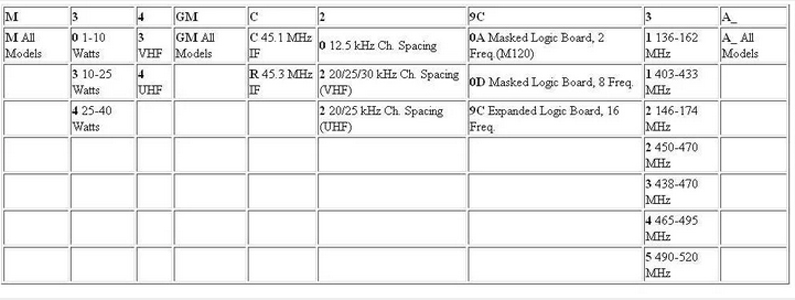THIS TRANSCEIVER HAS ONLY BEEN PARTIALLY TESTED AND FURTHER INVESTIGATION IS REQUIRED
It is very important that those interested in this transceiver to read EVERYTHING in this detailed description so that you can gain an idea of what needs to be done!
HISTORY:
In a previous life I was heavily involved in professional communications (Maritime) and on a personal level, Amateur radio (ex VK2DWF and now relinquished for some years) so of course I collected radio equipment and to a certain extent still do "just for fun" but these days I am "over it all" and have been working through a box of radio equipment sitting in the storage units.
Some of the most well designed and manufactured equipment comes from MOTOROLA and this dated (early 1990's) equipment is no exception.
It was a long time ago but I seem to recall this gear was ex-commercial use, a nice rugged unit from the days of basic analog radio communications (25Khz bandwidth) but with a greater flexibility than other gear out "there" in those days e.g remote channel switching I think was possible via the rear connector port and so much more.
These GM300's are still a favourite amongst the Amateur radio fraternity due to their low cost (now), flexibility and ease of use USUALLY although as with all dated equipment, programming can at times present challenges and just plain old component failures do at times occur. Fortunately there is a wealth of information online about these GM300's, their common problems and how to solve programming hardware and software issues.
If you are looking for a transceiver that you can power up and start talking immediately to your fellow mates (THIS GM300 IS NOT SUITABLE FOR PROGRAMMING FOR USE ON UHF CB FREQUENCIES), this equipment is NOT FOR UHF CB FREAKS!
If however you have "some" technical abilities in relation to radio equipment (RIB's, programming & possibly radio comms equipment diagnosis and servicing), this may be a fun thing to play around with.
Please read on for the details of this MOTOROLA GM300 mobile transceiver ...
MOTOROLA (USA) - COMMUNICATIONS TRANSCEIVER
Designed in USA
Country of manufacture is Malaysia
Series: GM300
Model #: M04GMC29C3AA
Analog FM UHF Transceiver
Frequency range: 438 - 470Mhz
16 Channel capability - user programmable
45.1Mhz IF
20/25Khz channel spacing
RF power output: 1 ~ 10W
If you don't already have this information, here is a chart so you can decode those GM300 code sequences (Motorola loves codes!)

Internal speaker fitted
Basic front panel using rubberised push button controls with the exception of ON-OFF/Volume control
Green LED display with surrounding function LED's e.g SCAN, TX etc
MINI UHF female Antenna connector*
Most users need to find a Mini UHF male to UHF female SO239 or (better for UHF) a BNC female connector to connect the antenna.
16 way (8 x 2 rows) rear auxiliary connector
DC (nominally 13.2V) is supplied into the transceiver using a heavy duty two pin (male & female in one) connector.
Plug to suit is supplied
NO in-line fuse is fitted
ITEMS NOT SUPPLIED:
A microphone is NOT supplied but is available as a separate item HERE
NOTE: I have serious doubts about this microphone being an original Motorola but it is a very well made mic none-the-less
Mounting bracket and thumb screws are NOT supplied
DIMENSIONS:
180mm wide x 195mm depth x 50mm height
WEIGHT:
1.75Kg
COSMETIC CONDITION:
USED
CLEAN
NO physical damage to the main body and front panel
DC lead is nice with heavy multi-strand core conductors - NO in-line fuse holder is fitted
I took a quick look inside the front panel (easy to access via 2x LONG bolts), all clean, neat and tidy
Barely any scratching to the outer high impact plastic top/bottom sections - plastic? I hear you say .... this is like a skin fitted over the metal frame.covers etc underneath (also easy to remove, 4x screws to be removed and the plastic skin will lift off)
NOTE: the screws have what looks like a hex head (I can't remember what they are called - it's an age thing!) so you will need a special driver to undo these - well maybe not that special, I had one!
TESTING:
This is the part that really matters!
On the rear 16 way connector I have a connected a "push on" jumper across pins 15 & 16 - without this jumper you would never hear audio from the internal speaker. I will supply the transceiver with this jumper in place.
I found a power supply providing 13.6V and this was used for testing. The current capability is only 3A but that really didn't matter because I was sure this GM300 was not about to start transmitting!
Why?
As is standard practice (or it used to be), when commercial/professional radio equipment is disposed of, ALL programming is deleted - its just the responsible thing to do. So I am 100% sure that this GM300 had no programmed frequencies or facilities at all - I was right! (read on)
Just a side story here though ... it always pays to double check that any radio equipment you have obtained second hand has indeed been erased (or in extreme cases I have seen an EPROM physically removed)
A LONG time ago, well before APCO25 and encryption systems were in use by the NSW Police, I found an XPS6000 (I think it was from memory) and damn! it was live ... the battery charged up, I hit the key and made a test call and Woah Neddy! "Radio" came back to me asking for my identification. Of course I immediately shut down and erased the programming myself. So second hand gear is not always what you might expect.
These days of course it would be a different story, on the digital systems I would just get "bricked" - end of story.
Back to the GM300 ...
Power ON and the display comes alive
Displays 1
No sound because the squelch is active but far more importantly, no RX frequency is set!
I pushed the MON button and the Orange MON LED comes on AND the TX RED LED flashes - this is normal
Channel changing (using the push buttons UP & DOWN) does not change anything, there are no channels programmed - this display always shows 1
Pushing the SCAN button and the Green SCAN LED comes on PLUS the digit 1 flashes AND a left hand Green segment of the display also flashes. I have tried to show this in one or more of the photographs.
Pushing the SCAN button yet again and I now get 3 horizontal lines, they just sit there doing nothing extraordinary.
The +/- button does nothing at all visible
While the MON function is active, I do have VERY LOW LEVEL white noise (even at full volume) and I expect this is due to no RX frequencies being programmed.
Attempts to key up the transmit do nothing, again this is expected ("transmit on what frequency? it could be asking itself")
So the first step for someone who would like this transceiver is to get out their RIB and some programming software (with a PC) so that they can talk to the GM300 and starting to "plug in" some parameters.
Only after doing this will it be possible to check the RX/TX functionality - it "could" be fine but it has been around 20 years since I have taken this out of the "radio box of goodies" - it worked 20 years ago but now ....
Fortunately there is a vast amount of information online in various forums about the GM300 and related products from MOTOROLA - in a worse case scenario you could join a group and fire away with your questions.
So there you have it, a dated high quality analog UHF transceiver from Motorola which just needs to be reprogrammed before firing up on the high end of the 70cm band (repeater OUTPUTS sit up here, with the inputs being 5Mhz below)
You could also program the RX side ONLY up in the high end 465 ~ 470Mhz which is where the NSW Police primary communications occur but that would be pretty useless an exercise as they have used digital trunked transmissions along with encryption keys for a very long time now. All you would hear is strange "blurts" of noise!






















